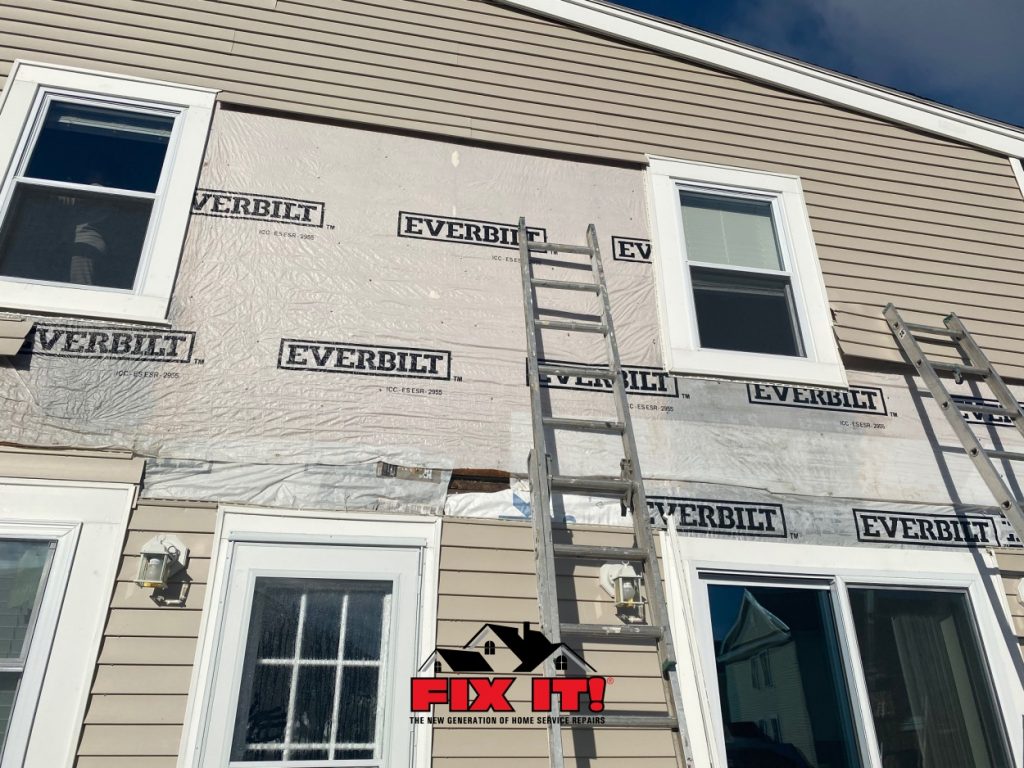Storms show no mercy. They’ll wreak havoc on everything in their path – and sometimes, that includes your home’s siding. While your focus should be on staying safe during the storm, what do you do when the sun finally peeks through those dark clouds, and the dust settles? Let’s take a look at the steps that you need to take if your home’s siding has been damaged.
Evaluate the Severity of the Siding Damage
The first thing that you need to do is to evaluate the extent and severity of the damage. Did the storm simply leave behind mud, dirt, and debris, or is there actual damage to the siding? Signs of serious damage include boards that have been torn off of your home, boards that are bent or detached in certain areas, and boards that have been severely scratched or dented.
If you have fiber-cement siding installed on your home, in most cases, you’ll discover that the damage isn’t actually damage at all. Fiber cement siding typically holds up well under normal storm conditions. If there’s a large amount of mud and debris on the siding, a heavy dose of pressure washing can generally bring your siding back to its previous condition. However, if you think that things are a little more serious, don’t be afraid to bring in some outside opinions.
Contact Your Insurance Agent if Necessary
Before moving too far along in the process, contact your insurance agent. You won’t be the only client in the area placing a phone call, and they’ll tell you exactly how to proceed. However, prior to contacting your agent, it’s a good idea to have a licensed storm restoration contractor come pay your home a visit.
An inspector will provide you with a full report that details the total amount of damage done to your property and will give a ballpark estimate of how much it’ll cost to restore the home to its original condition. Not only will they look at your siding, but they’ll also meticulously look over the other portions of your home – including the roof, windows, doors, concrete, HVAC units, decks, and anything else that may have been affected.
Once you have this information, you can then give your agent a call. They’ll dispatch an insurance adjuster to handle the claim (if one’s needed). It’s important that you consider your options carefully, though. Many insurance companies will drop homeowners who file two claims within a few years of each other. Your agent can help you to determine whether it makes more sense to repair it on your own or to file a claim.
Understand the Details of Your Coverage
One of the problems with repairing or replacing siding is that you have to get an exact match. Otherwise, the appearance of your home will be seriously altered. While you should be able to find a match, it isn’t always possible. In these situations, you should read your policy to learn more about your options. Many policies include extra provisions for re-siding the entire home, even if only a small portion was damaged.
Here are some important things to remember when contacting your insurance company:
- Most insurance policies require you to contact your agent, and file a claim within an allotted timeframe. Keep this in mind, and act quickly.
- Always have an independent restoration contractor provide an estimate. They have your best interests in mind, even when your insurance company may not.
- As mentioned, you can be dropped from your policy after filing even two claims in the span of a few years. Ask your agent about the likelihood of this happening.
- Always read through your policy so you can understand your rights. If you have any questions, ask your agent.
How to Handle Quick DIY Fixes to Your Siding
As previously mentioned, pressure washing can remove the dirt and debris that a storm may have left behind on your siding. However, if there are misplaced boards, the job becomes exponentially more challenging.
While it’s suggested that you contact professionals to handle any amount of storm damage, we understand that it doesn’t always make sense to go through the trouble of calling someone out to your home when there’s nothing more than a misplaced board or two.
It’s possible to replace a piece of siding by yourself, but if you have fiber-cement siding you need to be extra be careful. Most fiber cement is blind-nailed, which means the nails are just beneath the overlap of the course above it. This makes it trickier than with regular clapboards to get the nails cut and to extract the piece.
In order to replace a piece of fiber-cement siding, you have to identify where the nails are, pry the siding to expose the nails, cut the nails, remove the piece, and then insert the new board. During the whole process, make sure to protect the pieces of siding over and below the piece that you’re replacing.
We recommend that for any type of fiber-cement siding repairs, you call a siding professionals, that specializes in fiber-cement siding. As much as we’d like to tell you that you can handle it on your own, it’s too risky to take a DIY approach to an aspect of your home that’s so visible and valuable.
Fix It!® can take Siding Repair off your to-do list. One call really does take care of some on your to-do list. Make sure to stay on top of all your household repairs, improvements and maintenance needs and request service now online.



